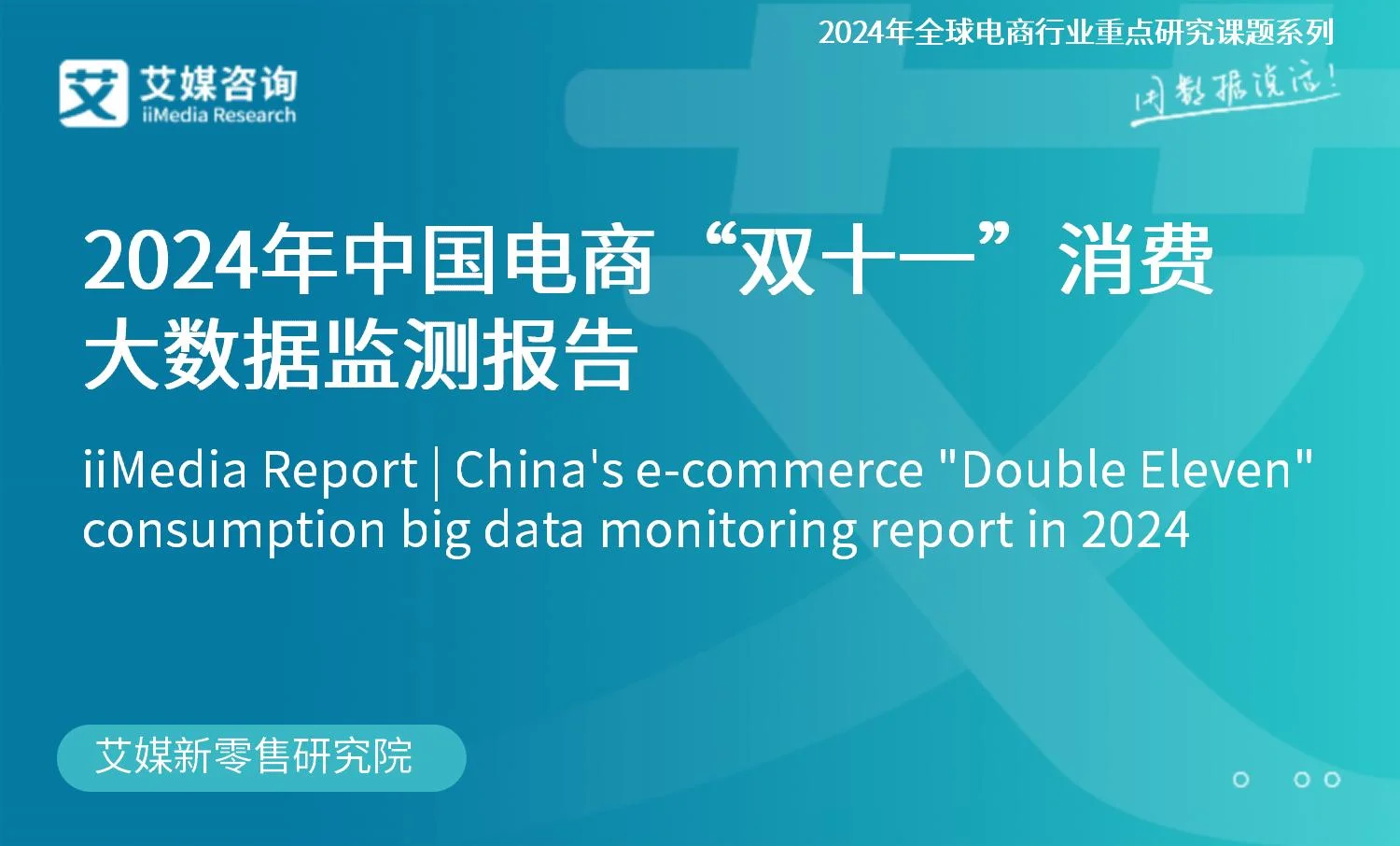全球领先的新经济产业第三方数据挖掘与分析机构
- 全部
- 互联网
- 快消品
- 战略新兴产业
- 电子信息产业
- 新零售
- 新金融
- 新出行
- 智慧物流
- 旅游酒店
- 大健康
- 大文娱
- 未来教育
- 体育
- 餐饮
- 纺织服装
- 家电家居
- 服务业
- 其他
艾媒咨询 | 2025年中国电商“双十一”消费大数据监测报告
2025年“双十一”期间,随着大促周期的持续延长,消费者对前期预热活动的关注度呈现疲态,整体参与热情未出现显著提升。平台转向“直降让利”简化规则,AI与即时零售成为新引擎,情绪消费等品类热销。市场从流量争夺转向存量深耕,理性消费主导,品牌更注重价值与服务竞争。根据全球领先的新经济产业第三方数据挖掘和分析机构iiMedia Research(艾媒咨询)最新发布的《2025年中国电商“双十一”消费大数据监测报告》显示,按需购买(34.6%)和拒绝冲动消费(31.8%)是消费者“双十一”热情下降的核心因素,凸显理性消费理念已深度渗透;年度最优价格(44.6%)和优惠简化直接(42.6%)仍是拉动消费热情的关键。近年来,消费者需求已从单纯价格敏感转向高品质、智能化、情绪价值等多元维度,这一理念迭代正倒逼品牌加速产品创新升级。品牌需聚焦用户真实需求精准发力,激活消费者“焕新”意愿,推动行业实现可持续增长。
During the "Double Eleven" period in 2025, with the continuous extension of the big promotion cycle, consumers' attention to the pre heating activities has shown signs of fatigue, and the overall enthusiasm for participation has not significantly increased. The platform is shifting towards simplified rules of "direct reduction and profit sharing", with AI and instant retail becoming new engines, and emotional consumption and other categories selling well. The market has shifted from competition for traffic to deep cultivation of stock, with rational consumption leading and brands placing more emphasis on value and service competition. According to the latest "2025 China E-commerce 'Double Eleven' Consumption Big Data Monitoring Report" released by iiMedia Research, a leading global third-party data mining and analysis institution for the new economy industry, on-demand purchasing (34.6%) and refusal of impulse consumption (31.8%) are the core factors leading to the decline in consumer enthusiasm for Double Eleven, highlighting the deep penetration of rational consumption concepts; The annual best price (44.6%) and simplified discounts (42.6%) are still the key factors driving consumer enthusiasm. In recent years, consumer demand has shifted from simple price sensitivity to multiple dimensions such as high quality, intelligence, and emotional value. This concept iteration is forcing brands to accelerate product innovation and upgrading. Brands need to focus on the real needs of users, exert precise efforts, activate consumers' willingness to "rejuvenate", and promote sustainable growth in the industry.艾媒咨询 | 2025年中国无人零售行业发展状况与用户行为调查数据
随着物联网、人工智能、大数据等前沿技术深度嵌入零售领域,中国无人零售行业近年来一路高歌猛进,从概念试水逐步迈向大规模商用,展现出强大的发展活力。根据全球领先的新经济产业第三方数据挖掘和分析机构iiMedia Research(艾媒咨询)最新发布的《2025年中国无人零售行业发展状况与用户行为调查数据》数据显示,2024年中国人均可支配收入突破40000元大关,达到41314元。在2024年中国居民移动电话普及率达到了127.10部/百人。上述数据足以说明以物联网、大数据等前沿技术为核心的无人零售市场发展前景广泛。在对无人零售行业了解情况调查中,有50.41%的无人零售用户表示听说过,较为了解的用户占比为38.14%,这表明绝大部分用户都对无人零售有一定的认知。在对便利程度影响中,46.85%的用户认为略微提高,18.10%的用户认为显著提高,说明中国无人零售行业对用户生活便利程度带来了较大的正面影响。在无人零售商店未来改进空间看法中,62.76%的无人零售用户希望进行购物流程和支付方式的优化,59.51%的用户希望对店内环境和设施进行改善。这说明尽管无人零售行业具有巨大市场,但在精细服务方面仍然需要优化和改进。艾媒咨询分析师认为,未来中国无人零售行业需在技术稳定性、商品品类丰富度、运营成本控制等方面持续发力。企业应加大研发投入,提升设备稳定性与智能化水平,优化购物流程;同时,精准洞察消费者需求,丰富商品供给,通过精细化运营,进一步释放无人零售的市场潜力,塑造更具竞争力的商业模式。
With the deep integration of cutting-edge technologies such as the Internet of Things, artificial intelligence, and big data into the retail sector, China's unmanned retail industry has been making rapid progress in recent years, gradually moving from conceptual trials to large-scale commercial use, demonstrating strong development vitality. According to the latest "iiMedia Report | Survey data on the development status and user behavior of China's unmanned retail industry in 2025 " released by iiMedia Research, a world-leading third-party data mining and analysis institution for the new economy industry, China's per capita disposable income exceeded 40,000 yuan in 2024, reaching 41,314 yuan. In 2024, the penetration rate of mobile phones among Chinese residents reached 127.10 per 100 people. The above data are sufficient to demonstrate that the unmanned retail market, centered on cutting-edge technologies such as the Internet of Things and big data, has a broad development prospect. In the survey on the understanding of the unmanned retail industry, 50.41% of unmanned retail users said they had heard of it, and the proportion of users who were relatively familiar with it was 38.14%. This indicates that the vast majority of users have a certain understanding of unmanned retail. In terms of the impact on convenience, 46.85% of the users think it has slightly improved, and 18.10% of the users think it has significantly improved, indicating that the unmanned retail industry in China has brought a considerable positive impact on the convenience of users' lives. Among the views on the future improvement space of unmanned retail stores, 62.76% of unmanned retail users hope to optimize the shopping process and payment methods, and 59.51% of users hope to improve the in-store environment and facilities. This indicates that although the unmanned retail industry has a huge market, it still needs optimization and improvement in terms of fine services. Analysts from iiMedia Research believe that in the future, China's unmanned retail industry needs to continue to make efforts in terms of technological stability, the richness of product categories, and the control of operating costs. Enterprises should increase investment in research and development, enhance the stability and intelligence level of equipment, and optimize the shopping process. At the same time, accurately understand consumer demands, enrich product supply, and through refined operation, further unleash the market potential of unmanned retail and shape a more competitive business model.艾媒咨询 | 2025年中国零售行业市场消费行为调查数据
随着数字零售技术的深度融合创新,消费模式呈现多元化发展态势,主要应用于以直播购物、社交电商为例的流量重构领域,以会员体系运营、精准推荐算法为例的用户运营领域,以及即时零售、虚拟试穿技术等场景体验领域。这种技术演进推动形成了覆盖智能货架管理、跨境商品直购的新型消费生态,同时催生出结合AR导航、无人配送的智慧零售解决方案,为消费者构建起全时段、全场景的购物体验闭环。根据全球新经济产业第三方数据挖掘和分析机构iiMedia Research(艾媒咨询)最新发布的《2025年中国零售行业市场消费行为调查数据》数据显示,2025年中国消费者选择线上购物的核心动因中,“商品选择丰富性”以39.14%的占比居于首位,反映出消费者对多元化需求的重视。线上购物频率呈现集中化特征,“每月2-3次”成为主流选择,占比达35.45%,而每周线上购物时间分配中,“1-3小时”以55.74%的绝对优势成为多数消费者的常态选择。在消费类目偏好方面,食品类商品以36.68%的消费占比领跑线上购物清单,印证了生鲜电商和即时零售场景的深度渗透。艾媒咨询分析师认为,零售企业需系统性优化线上线下一体化运营能力:在线上渠道应强化动态定价算法与供应链弹性,通过C2M模式降低溢价空间;线下场景需加速AR虚拟试穿、智能导购机器人等体验型技术部署,同时构建会员积分跨场景通兑体系以提升用户忠诚度。对于消费者普遍反映的“价格敏感度攀升”现象,建议通过大数据驱动的精准促销策略与付费会员专属权益体系实现差异化价值供给。
With the deep integration and innovation of digital retail technology, the consumption model shows a diversified development trend, which is mainly applied to the field of traffic reconstruction such as live shopping and social e-commerce, the field of user operation such as membership system operation and accurate recommendation algorithm, and the field of scene experience such as instant retail and virtual fitting technology. This technological evolution has promoted the formation of a new consumption ecology covering intelligent shelf management and cross-border direct purchase of goods, and has spawned a smart retail solution combining AR navigation and unmanned distribution, building a full-time and full-scene shopping experience closed-loop for consumers. According to Consumer behavior survey data of China's retail industry in 2025 released by iiMedia Research, a third-party data mining and analysis institution in the global new economy industry, among the core motivations for Chinese consumers to choose online shopping in 2025, "Product selection richness" ranked first with 39.14%, reflecting consumers' emphasis on diversified needs. Online shopping frequency presents a centralized feature, "2-3 times a month" has become the mainstream choice, accounting for 35.45%, and in the weekly online shopping time allocation, "1-3 hours" has become the normal choice of most consumers with an absolute advantage of 55.74%. In terms of consumer preference, food products led the online shopping list with 36.68% of consumption, confirming the deep penetration of fresh e-commerce and instant retail scenes. Analysts of IIMedia Consulting believe that retail enterprises need to systematically optimize online and offline integrated operation capabilities: online channels should strengthen dynamic pricing algorithms and supply chain elasticity, and reduce premium space through C2M mode; In offline scenes, it is necessary to accelerate the deployment of experiential technologies such as AR virtual fitting and intelligent shopping guide robots, and build a cross-scene redemption system for member points to enhance user loyalty. For the phenomenon of "rising price sensitivity" generally reflected by consumers, it is suggested to realize differentiated value supply through big data-driven precision promotion strategy and the exclusive rights and interests system of paying members.艾媒咨询 | 2024年中国电商“双十一”消费大数据监测报告
“国补”政策与 “双十一”大促周期拉长,共同激发了2024年“双十一”消费热潮。全球新经济产业第三方数据挖掘和分析机构 iiMedia Research(艾媒咨询)最新发布的《2024年中国电商“双十一”消费大数据监测报告》数据显示,2024年参与“双十一”活动的消费主力为26-29岁年轻群体,占比34.1%;“双十一”活动中购买量最多的TOP3商品类别为生活日化、服装鞋帽和美妆护肤,“悦己消费”、消费分层等需求趋势凸显;延时发货(44.0%)和假优惠(42.7%)是消费者“双十一”消费体验中的短板。2024年双十一周期提前,旨在抢占市场先机,但也导致消费者购物疲劳和商家物流压力的增加。电商平台竞争从价格战转向经营战,通过细分人群与购物场景,升级服务支持商家。未来,竞争态势和策略调整还将继续深化和演变。
The "National Subsidy" policy and the extended "Double Eleven" promotion period have jointly stimulated the consumer fervor for "Double Eleven" in 2024. According to the latest " China's e-commerce "Double Eleven" consumption big data monitoring report in 2024" released by iiMedia Research (a third-party data mining and analysis institution for the global new economy industry), the main consumers participating in the 2024 "Double Eleven" event were young people aged 26-29, accounting for 34.1%. The top three product categories purchased during the "Double Eleven" event were daily necessities, clothing and footwear, and beauty and skincare products, highlighting trends such as self-indulgent consumption and consumption segmentation. Delayed delivery (44.0%) and fake discounts (42.7%) were the weak links in consumers' "Double Eleven" shopping experience. The 2024 "Double Eleven" cycle started earlier to seize market opportunities, but it also led to increased shopping fatigue among consumers and logistical pressures on merchants. Competition among e-commerce platforms shifted from price wars to operational battles, upgrading services to support merchants through audience segmentation and shopping scenarios. In the future, the competitive landscape and strategic adjustments will continue to deepen and evolve.
- 1
- 2
- 3
- 4
- 5
- 6
- 21


















